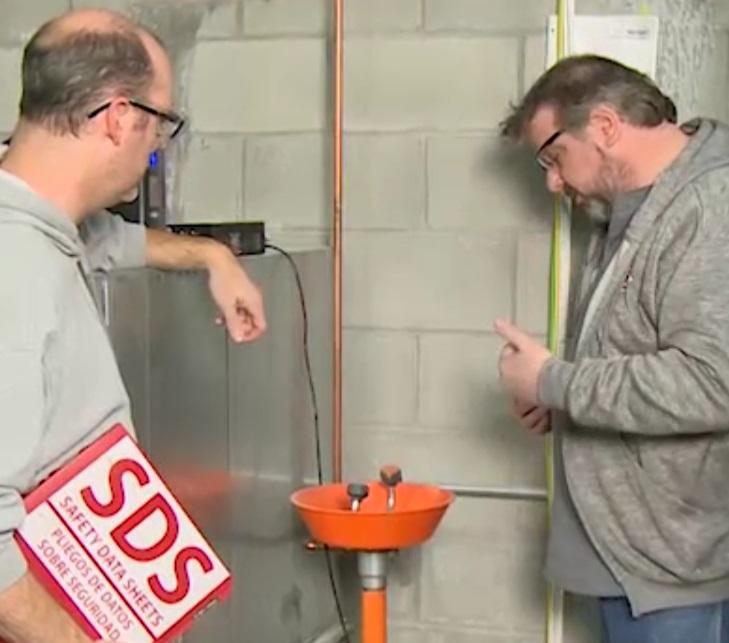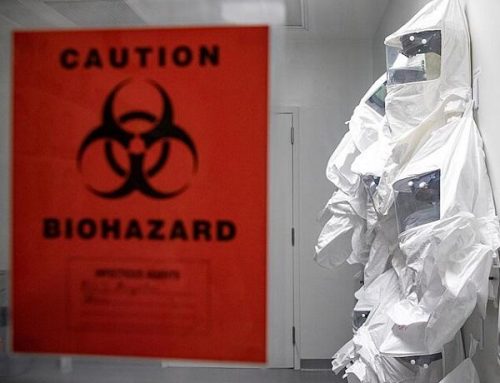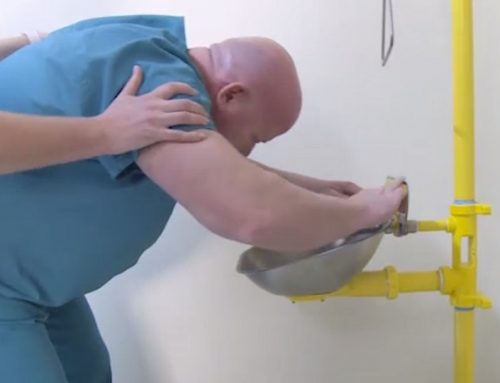This article is excerpted from an online training course on general workplace safety. It provides a detailed overview of safety showers and eye wash stations, which are critical emergency response equipment in facilities that handle hazardous materials.
Workplace accidents involving hazardous materials (HAZMATs) can cause severe injuries and permanent damage if the substances are not flushed away immediately. Safety showers and eye washes dilute and wash away corrosives, irritants, and other dangerous chemicals to mitigate harm.
Proper use of this safety equipment combined with timely medical attention can mean the difference between a close call and tragedy. Read on to learn about OSHA requirements, ANSI standards, proper operating procedures, and how to respond in the crucial minutes after an accidental HAZMAT exposure.
Why Safety Showers and Eye Washes Are Critical
Any company that handles hazardous materials has a responsibility to safeguard its employees from accidental exposures. Safety showers and eye washes provide the first line of defense when the unthinkable occurs.
These devices work by drenching the body and/or rinsing the eyes with large volumes of water or other appropriate fluids. This dilution and flushing action carries away contaminants and minimizes the length of exposure. The quicker the substance can be washed away, the less damage it can do.
For highly corrosive chemicals that can literally burn the skin and eyes, immediate flushing is imperative. Severe, even fatal injuries can occur in seconds. Areas of the body not reached by water will continue to “cook” in the chemical.
Other types of hazardous materials that may require emergency flushing include:
- Irritants like solvents, detergents, and degreasers
- Toxins such as chemical reagents, pesticides, and petroleum products
- Biological hazards like bodily fluids containing pathogens
Without accessible eye washes and safety showers located throughout a facility, severe or permanent injury and possible death can result from accidental exposures.
OSHA Requirements for Corrosives
The Occupational Safety and Health Administration (OSHA) recognizes the extreme hazard posed by accidental exposures to corrosive materials.
OSHA 1910.151(c) states:
“Where the eyes or body of any person may be exposed to injurious corrosive materials, suitable facilities for quick drenching or flushing of the eyes and body shall be provided within the work area for immediate emergency use.”
Employers must install emergency eyewashes and showers meeting appropriate ANSI standards wherever corrosives are used. This includes laboratories, industrial facilities, and any other locations where corrosive liquids, solids, gases, or airborne mists are handled.
OSHA also requires worker training on how to properly use safety showers and eye washes in an emergency. Annual hands-on exercises reinforce how to find the units quickly and operate them effectively when vision may be impaired or panic sets in.
ANSI Standards for Design and Performance
While OSHA sets overall requirements for emergency response equipment, the American National Standards Institute (ANSI) has established consensus standards governing the design, installation, and performance of safety showers and eye/face washes.
These standards are laid out in ANSI/ISEA Z358.1, most recently updated in 2014. Compliance is voluntary, but provides important guidance to ensure equipment effectiveness. Key provisions include:
Location: Showers and eye wash units must be accessible within 10 seconds or 55 feet of chemical exposure areas. This allows quick initiation of flushing.
Surface: The area around the equipment should have an anti-slip surface to prevent falls during use. Good drainage is also critical.
Spacing: A clear floor area of at least 16 inches must be provided around each unit, with at least 24 inches between multiple units. This allows unobstructed use.
Water Flow: Eye and eye/face wash equipment must deliver at least 0.4 gallons of water per minute for 15 minutes. Showers must deliver 20 gallons per minute for the same duration.
Water Temperature: To encourage lengthy flushing, ANSI calls for tepid water between 60-100°F. Higher and lower temperatures may discourage full 15 minute use.
Valves/Activation: Units must be capable of quick activation in one second or less using a valve that stays open without requiring further use of operator’s hands. This “hands-free” operation allows the victim to hold eye lids open.
Water Heads: Spray heads must be positioned appropriately for various types of units: 33-53 inches from surface for eye wash, 33-45 inches for eye/face wash, 82-96 inches for fixed shower heads.
Maintenance: Units should be activated weekly to flush lines and verify proper operation. Annual inspections check that ANSI criteria are met.
These requirements work together to facilitate fast and thorough decontamination. When shopping for new units, look for ANSI Z358.1 certification to ensure standards are met.
Common Types of Eye Washes and Showers
There are many varieties of emergency flushing equipment available to meet different needs:
Wall-Mounted Eye Washes: Incorporate spray heads into a wall-mounted fixture plumbed into facility water lines. Used for eye exposure only.
Sink-Mounted Eye Washes: Attaches to existing sink plumbing to provide emergency flushing. Used for eye exposure only.
Counter-Mounted Eye Washes: Self-contained units mounted on counters or benches with small integral water tank. Used for eye exposure only.
Gravity-Fed Eye Washes: Contains fluid which irrigates eyes under force of gravity when activated. Used for eye exposure only. No plumbing required.
Faucet-Mounted Eye Washes: Replaces existing sink faucet to provide emergency flushing. Used for eye exposure only. Attaches to existing plumbing.
Self-Contained Eye Washes: Freestanding unit with built-in water reservoir. May be operated by foot pump, hand pump or compressed air. Used for eye exposure only. No plumbing required.
Wall-Mounted Shower/Drench Hoses: Secured to wall with hose of at least 30 inches to provide emergency shower using facility plumbing. For full body exposure.
Floor-Mounted Self-Contained Showers: Freestanding unit with water reservoir provides complete drenching of body via shower heads. No plumbing required.
Overhead Mounted Safety Showers: Heads are mounted overhead and connected to facility plumbing to deliver complete drenching using pull chain or lever activation. For full body exposure.
Combination Units: Incorporate integrated eye wash, eye/face wash and shower capabilities in one body. For both eye and full body exposure. May be wall mounted or freestanding.
The right choice depends on types of hazardous materials used, number of exposed employees, and facility layout and plumbing. Carefully weigh options and requirements when selecting and installing units.
Proper Use of Safety Showers
In the event of large splash, spill or other full-body exposure to a hazardous material, immediately locate the nearest safety shower. Seconds count, so verbalize the nature of the emergency to alert nearby coworkers who can assist you. While making your way to the shower, do your best to avoid rubbing your eyes and face, which could worsen exposure. Leave any contaminated personal protective equipment on. Once at the shower:
- Pull the activation lever or ring with a quick, single motion. Water should immediately begin flowing.
- While still clothed, stand under the shower and allow the water to thoroughly saturate your clothing. This will begin diluting the chemical.
- With assistance from a coworker whenever possible, promptly remove all contaminated clothing, shoes, and jewelry to eliminate further contact and absorption of the substance. This should be done in the first minute if possible.
- Continue showering for 15 minutes minimum while using your hands to spread water over any potentially exposed skin. Keep your eyes closed and face angled away from the spray.
- Resist the urge to turn off the water before 15 minutes. Some effects of chemicals are delayed. Complete flushing is a must.
- Avoid walking while chemicals are on your feet. Stay under the shower until EMTs arrive if medical assistance has been summoned.
- Shower assistants and the victim should undergo additional showering after minutes if the substance warrants it.
- After use of the shower, it’s imperative to seek professional medical assessment and treatment per facility policy. Provide SDS of chemical when EMTs arrive.
Proper use of safety showers plays a crucial role in mitigating harm after an accidental exposure. But it is just the first step in the emergency response process. Never hesitate to activate your facility’s emergency response plan and get immediate medical attention. Permanent injury or loss of life is possible even with proper shower usage.
Proper Use of Eye Washes
If a hazardous material splashes, splatters or mists into the eyes, every second counts. Take the following steps immediately:
- Verbalize the nature of the emergency and proceed cautiously to the nearest eye wash with assistance from a coworker whenever possible. Do your best not to rub your eyes.
- If wearing contacts, do NOT delay flushing by trying to remove them. Begin irrigating eyes immediately and remove contacts once in the eye wash if possible.
- Activate the eye wash unit with a quick pull, push or turn of the valve so water flows freely. No part of the body except the eyes and face should enter an eye wash unit.
- Place your eyes in the path of the flowing water. Open your eyes as wide as possible using your fingers if needed so water contacts all eye and lid surfaces. Roll your eyes around and blink repeatedly in the water flow.
- Flush in this manner for 15 minutes minimum, occasionally rotating between eyes to ensure thorough rinsing of all surfaces. Resist the urge to stop before 15 minutes have passed.
- If only one eye is affected, take measures to avoid contaminating the other eye. Position head with affected eye lower and turn face so rinse water flows away from unexposed eye.
- Seek immediate professional medical assistance after use of the eye wash. Provide SDS of chemical to EMTs when they arrive.
Proper eye wash technique is imperative for safety after chemical eye exposure. But never hesitate to activate your facility’s emergency response plan and get immediate medical attention. Permanent loss of vision is possible even with proper eye wash usage if the chemical exposure is severe. seconds count, so verbalize the nature of the emergency to alert nearby coworkers who can assist you. While making your way to the shower, do your best to avoid rubbing your eyes and face, which could worsen exposure. Leave any contaminated personal protective equipment on. Once at the shower:
- Pull the activation lever or ring with a quick, single motion. Water should immediately begin flowing.
- While still clothed, stand under the shower and allow the water to thoroughly saturate your clothing. This will begin diluting the chemical.
- With assistance from a coworker whenever possible, promptly remove all contaminated clothing, shoes, and jewelry to eliminate further contact and absorption of the substance. This should be done in the first minute if possible.
- Continue showering for 15 minutes minimum while using your hands to spread water over any potentially exposed skin. Keep your eyes closed and face angled away from the spray.
- Resist the urge to turn off the water before 15 minutes. Some effects of chemicals are delayed. Complete flushing is a must.
- Avoid walking while chemicals are on your feet. Stay under the shower until EMTs arrive if medical assistance has been summoned.
- Shower assistants and the victim should undergo additional showering after minutes if the substance warrants it.
- After use of the shower, it’s imperative to seek professional medical assessment and treatment per facility policy. Provide SDS of chemical when EMTs arrive.
Proper use of safety showers plays a crucial role in mitigating harm after an accidental exposure. But it is just the first step in the emergency response process. Never hesitate to activate your facility’s emergency response plan and get immediate medical attention. Permanent injury or loss of life is possible even with proper shower usage.
Proper Use of Eye Washes
If a hazardous material splashes, splatters or mists into the eyes, every second counts. Take the following steps immediately:
- Verbalize the nature of the emergency and proceed cautiously to the nearest eye wash with assistance from a coworker whenever possible. Do your best not to rub your eyes.
- If wearing contacts, do NOT delay flushing by trying to remove them. Begin irrigating eyes immediately and remove contacts once in the eye wash if possible.
- Activate the eye wash unit with a quick pull, push or turn of the valve so water flows freely. No part of the body except the eyes and face should enter an eye wash unit.
- Place your eyes in the path of the flowing water. Open your eyes as wide as possible using your fingers if needed so water contacts all eye and lid surfaces. Roll your eyes around and blink repeatedly in the water flow.
- Flush in this manner for 15 minutes minimum, occasionally rotating between eyes to ensure thorough rinsing of all surfaces. Resist the urge to stop before 15 minutes have passed.
- If only one eye is affected, take measures to avoid contaminating the other eye. Position head with affected eye lower and turn face so rinse water flows away from unexposed eye.
- Seek immediate professional medical assistance after use of the eye wash. Provide SDS of chemical to EMTs when they arrive.
Proper eye wash technique is imperative for safety after chemical eye exposure. But never hesitate to activate your facility’s emergency response plan and get immediate medical attention. Permanent loss of vision is possible even with proper eye wash usage if the chemical exposure is severe.
Emergency Response After Flushing
Activating on-site safety showers or eye washes is only the first step of emergency response following accidental chemical exposures. Further actions should be taken in line with your facility’s emergency response plan:
- Call for medical assistance: Emergency services such as EMTs should be contacted immediately. Provide details on the hazardous material from the SDS.
- Provide SDS to medical personnel: The SDS will advise EMTs on specific precautions, treatments, and PPE to manage exposure effects and keep themselves safe.
- Dispose of contaminated clothing properly: Clothes worn during chemical exposure are now hazardous waste. Follow regulations for disposal. Heavily contaminated items may need to be destroyed.
- Address contaminated run-off: Water from emergency showers and eye washes must be contained and disposed of according to hazardous waste regulations. Do not allow it to enter groundwater or sewers untreated.
- Shower/decontaminate assistants: Coworkers who provide emergency assistance should rinse themselves in case of secondary exposure.
- Investigate cause: Examine equipment, PPE, training and procedures to understand what led to the hazardous material exposure and prevent recurrence.
Also remember that the individual should be transported to a medical facility for assessment even after properly using on-site flushing equipment. Medical treatment within minutes greatly improves prognosis following chemical accidents.
Conclusion
Hazardous materials that spill, splash or mist onto the body or into the eyes can rapidly cause severe, permanent injury if not diluted and flushed away immediately. OSHA requires that employers provide accessible safety showers and eye washes wherever corrosives are handled, in conjunction with appropriate training. These devices supply copious amounts of water to drench the body and rinse the eyes when accidents occur. However, proper procedures must be followed to remove contaminated clothing and direct streams into the eyes to provide maximum benefit. After on-site decontamination, further emergency response actions should be taken, including immediate professional medical assessment and treatment. Safety showers and eye washes serve as an indispensable first line of defense against tragedies when hazardous materials are accidentally released in the workplace.
Recognizing the importance of this knowledge, we introduce our “Safety Showers and Eye Washes” online safety training course. This essential program is specifically designed to provide your employees with the critical skills and understanding needed to effectively handle hazardous materials (HAZMAT) emergencies. By engaging in this training, you are not only complying with regulatory standards but are also taking proactive measures to protect your workforce from potential injuries or worse.
Introducing Our “Safety Showers and Eye Washes” – an essential online safety training course designed to equip your employees with critical knowledge and skills for handling hazardous materials (HAZMAT) emergencies. This course is a vital component in ensuring the well-being and safety of your workforce.
Proactive Protection Against HAZMAT Injuries
Exposure to hazardous materials in the workplace can lead to severe injuries, including burns and blindness, or in extreme cases, even death. Our comprehensive training program provides the necessary education to utilize safety showers and eye washes effectively, offering a crucial line of defense in such emergencies.
Targeted Training for Maximum Impact
Our course covers key topics to ensure your employees are thoroughly prepared:
- Understanding HAZMATS and the importance of safety showers and eye washes.
- Familiarity with standards for decontamination equipment.
- Detailed instructions on using a safety shower.
- Step-by-step guidance on using an eye wash station.
- Best practices for post-HAZMAT decontamination procedures.
Micro-Learning for Efficient Learning
Our Micro-Learning approach, with 3-5 minute courses, makes complex information more digestible and easier to retain. This format is perfect for busy work schedules, ensuring that employees can learn essential safety skills without disrupting their daily workflow.
Accessible Learning for All Employees
We understand the importance of inclusive learning, which is why our courses are available in both English and Spanish. This ensures that every member of your diverse team has equal access to this vital training.
Comprehensive Learning Resources
In addition to our full-length online courses and Micro-Learning modules, Our also provides DVDs and interactive CD courses, catering to various learning preferences and ensuring a thorough understanding of safety protocols.
Empower Your Team with Essential Safety Skills
Choose Our “Safety Showers and Eye Washes” course to empower your employees with the knowledge and skills they need to respond effectively in HAZMAT situations. We are committed to helping you create a safer, more prepared workplace.
For a detailed course outline and to experience a demo of Our Online Training System, click below. Let’s work together to ensure your workplace is a safe environment for everyone.










